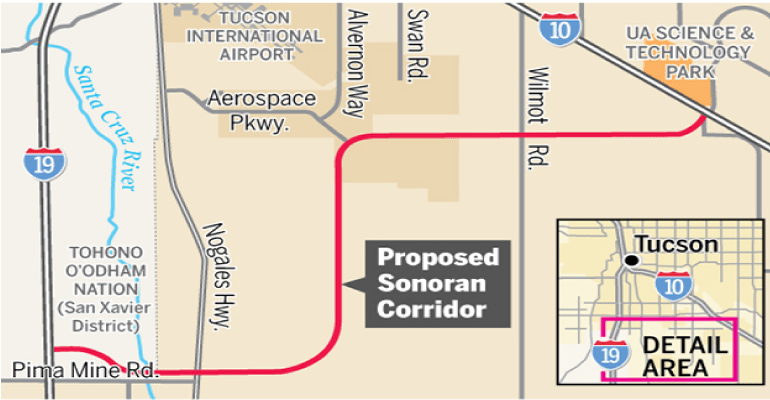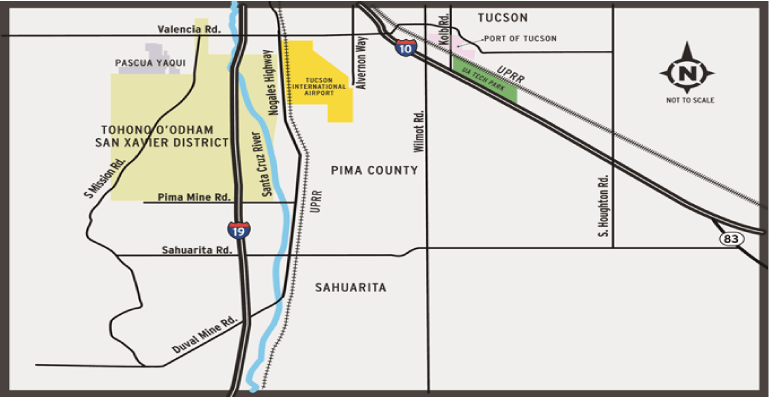
The Arizona Dept. of Transportation (ADOT) has just announced the opening of the Tier 1 Environmental Impact Study (EIS) for Tucson’s Sonoran Corridor. Four years ago Pima County Administrator Chuck Huckelberry set out a route, at first labeling it as the eastern leg of his proposed Avra Valley Interstate 11 route. When the Avra Valley Coalition pointed out that this looked like a ploy to hook up with his Avra Valley I-11 route at I-19 and create a fait accompli, the I-10 – I-19 – I-11 connector was renamed the Sonoran Corridor. The corridor was also named in the 2015 FAST Act with bipartisan amendments from Arizona’s congressional delegation making it a federal priority, along with I-11.
That history, ADOT tells us, should be ignored: “Any map, graphic or information that displays ‘proposed,’ ‘preferred,’ ‘ideal’ or any other route for the proposed Sonoran Corridor is inaccurate and should be disregarded. Although some agencies and entities other than ADOT have produced and shared such maps, graphics and information, ADOT advises that no route has been identified or selected.” The goal of the EIS is to identify a “reasonable range” of potential routes in line with the National Environmental Policy Act.
ADOT seems to contradict itself by setting one of the two public scoping meetings in Sahuarita, where Huckelberry’s route drops some seven miles south of the present Aerospace Parkway and airport and duplicates a long-planned El Toro Corridor in central Sahuarita.
The purpose of a Sonoran Corridor, according to Pima County, is primarily to provide infrastructure assistance to Raytheon, the University of Arizona Tech Park, and Tucson International Airport. Voters, however, decisively rejected a 2015 bond proposal to provide $30 million to begin the required studies. That raises several public policy issues.
What does the “will of the people” actually mean? If voters have rejected it, how can Pima County, and now ADOT, ignore that mandate and continue to pursue it? Further, should public money be spent on behalf of profitable businesses? The public said no in the bond election, but that is now being ignored.
Raytheon’s annual net profit is $2.2 billion. While technically a non-profit, Tucson Airport Authority’s assets exceeded liabilities in 2014 by $365.7 million. The University Tech Park estimates its economic impact at $1.7 billion, generating $50 million in taxes. They take in some $12 million annually in rent from their lessees, a number of whom are Fortune 500 companies. None need public assistance.
A third issue is Board of Supervisors Resolution 2007-343 which concludes, “… the Pima County Board of Supervisors opposes the construction of any new highways in or around the County that have the stated purpose of bypassing the existing Interstate 10 as it is believed that the environmental, historic, archaeological and urban form impacts could not be adequately mitigated.” Huckelberry has tried to get around that by calling the Sonoran Corridor bypass an “auxiliary interstate.”
In a curious bit of Pima County maneuvering, when the Sonoran Corridor came before the Planning and Zoning Commission in 2014 it was approved by a “majority vote” of just half of the Commission’s ten members. Five voted Aye, two voted No, two abstained, and one was absent. County rules turn Roberts Rules upside down and count abstentions as Yes votes.
While ADOT has to satisfy NEPA requirements, Huckelberry’s Sonoran Corridor route is still very much on the table. Setting aside the public policy issues a case can be made for a reasonably straight east-west line connecting the two existing interstates, this is not what Huckelberry’s route follows. It drops south for about six miles, coincidentally (??) providing a free access highway to the planned 3000-acre Diamond Ventures Swan Southlands development. Don Diamond was by far the largest contributor to BOS Chair Sharon Bronson’s re-election campaign, and Bronson has long been a strong Huckelberry supporter.
Any east-west route could impact the Tohono O’odham’s San Xavier District, but Pima County has said publically they have a “partnership” with the District and the Casino on the Sonoran Corridor. Another choice might be going south on or near the Old Nogales Highway, but that would deprive Mr. Diamond of his access road. The Sonoran Corridor could also turn north alongside the airport, then jog west for less than two miles without infringing on Tohono O’odham land.
Two ADOT public scoping meetings are scheduled, both from 5:30 to 7 p.m. with a presentation at 6 p.m.: Wednesday, June 7, 2017, at the Radisson Hotel Tucson Airport, 4550 S. Palo Verde Road, Tucson; and Thursday, June 8, 2017, at the Santa Cruz Valley United Methodist Church, 70 E. Sahuarita Road, Sahuarita.
Comments can also be made by email to: Sonorancorridor@azdot.gov; Toll-free bilingual information line: 855.712.8530; or by mail: Sonoran Corridor Tier 1 EIS Study Team c/o ADOT Communications, 1655 W. Jackson St., Mail Drop 126F, Phoenix, AZ 85007. The comment period ends July 15. There is minimal information on their website: http://azdot.gov/planning/transportation-studies/sonoran-corridor-tier-1-environmental-impact-statement/overview.
In related news, a last-minute push by residents of the Avra Valley has sent well over 500 comment cards to ADOT opposing any I-11 route through their homeland. The comments were gathered over two Saturdays by community volunteers gathered at Picture Rocks and Sandario Roads, with several other neighbors at other locations. The comment period ends June 2. The Avra Valley Coalition estimates that comments supporting a “No-Build” option or following the existing I-10 corridor may double the total comments submitted to ADOT during the initial scoping process a year ago.
ADOT has been requested to comment on the Sonoran Corridor public policy issues raised here. Stay tuned!

